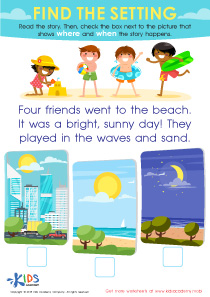Identifying shapes Easy Worksheets for Ages 4-6
3 filtered results
-
From - To
Boost your child's geometry skills with our "Identifying Shapes Easy Worksheets for Ages 4-6." These engaging and colorful worksheets are designed to help young learners easily recognize and differentiate between various shapes such as circles, squares, triangles, and more. Through fun activities like tracing, coloring, and matching, your child will enhance their fine motor skills and shape recognition abilities. Perfect for preschoolers and kindergarteners, these worksheets make learning enjoyable and effective. Download now and give your child a head start in mastering basic geometry concepts with Kids Academy's expertly designed educational resources.


Two–Dimensional Shapes: Vertices Printable


Robot Fun Worksheet


Help Sarah Be on Time! Worksheet
Identifying shapes is a foundational skill essential for young children's intellectual and cognitive development, particularly for those aged 4-6. At this early stage, recognizing and naming shapes like circles, squares, and triangles is not just about geometry; it forms a cornerstone for broader learning and understanding.
Firstly, shape recognition enhances visual-spatial skills, which are crucial for reading and writing. Differentiating between shapes helps children recognize letters and numbers, as these are composed of different shapes and lines. For instance, understanding that ‘O’ is circular or ‘A’ is triangular supports literacy development.
Secondly, shape recognition fosters problem-solving and critical thinking. When children identify and classify shapes, they also engage in activities that develop logical thinking and reasoning. This ability extends to more complex math concepts such as patterns, symmetry, and structure used robustly in subjects like science, technology, engineering, and mathematics (STEM).
Additionally, learning shapes is integral to developing hand-eye coordination and motor skills. Activities that involve drawing or building shapes enhance fine motor skills and coordination.
Finally, early proficiency in shape identification increases a child's confidence and enthusiasm for learning. As children master this skill, they gain pride in their accomplishments, fostering a positive attitude towards future learning.
Thus, parents and teachers should actively engage children in activities that promote shape recognition to support multifaceted cognitive and academic growth.
 Assign to My Students
Assign to My Students



















